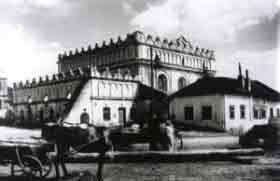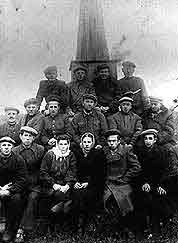Virtual Jewish World: Luboml, Ukraine
Luboml lies in an ambiguous area of changing borders and has belonged in succession to Russia, Poland, Lithuania, Poland, Russia and Poland. Today, Luboml is a market town about 200 miles southeast of Warsaw. It is a border town whose history dates back to the 11th century. Along with Chelm and Belz, it was part of the Eastern European region known as Volhynia — bordered by Lithuania on the north, Russia to the east, and Poland to the west.
 Luboml's Great Synagogue, ca. 1930 |
The Jewish community of Luboml dated back to the 14th century. By the 1930s, Libivne (as it was called in Yiddish) had a vibrant community of at least 4,000 Jews, which represented more than 90 percent of the city’s population.
The interwar years were a period of astonishing cultural ferment and change in this Polish shtetl (market town). While the family and traditional religious institutions continued to play a central role, they were joined and sometimes challenged by modern intellectual attitudes, styles of dress, and other secular influences (particularly Zionism) which increasingly made their way to this corner of eastern Europe.
The major architectural presence in Luboml was the Great Synagogue, built in the 17th century. Above the doorway of the fortress-like four-story structure, with its Moorish battlements, was the passage from Numbers 23.5: “How goodly are thy tents, O Jacob.”
 Survivors at an early monument to Holocaust victims in Luboml., ca. 1945 |
Many in the Jewish community were deeply involved in Zionist organizations, from the far left to the far right. The Betar movement (forerunner of the Likud Party in Israel) was one of the dominant factions. Menachem Begin, head of Betar in the 1930s and later Prime Minister of Israel, visited in 1934.
As anti-Semitism and the Nazi threat grew in the 1930's, Lubomlers able to leave began to emigrate. Some went to Palestine, others to the United States.
Luboml was occupied by the Soviets from 1939 until 1941, when the Germans took control and established a ghetto there. Ultimately, the Germans, assisted by Ukrainians and Poles, massacred the Libivner Jews in a series of “actions.” On October 1, 1942, the Germans, with the aid of Ukrainian police units, rounded up the remaining Jewish inhabitants of Luboml and marched them into the countryside. There the Jews were lined up in front of open pits and shot.
By the time the Soviet Red Army liberated Luboml in 1945, only 51 Jews from Luboml (excluding those who had emigrated before 1939) survived the Holocaust. More than 1,000 died in the mass execution on October 1, 1942. The German liquidation of the town effectively ended a six-century history and presence of Jewish life in Luboml.
Today Luboml is a part of the Republic of the Ukraine. There are no longer any Jews in the town.
Sources: Remembering Luboml - Images of a Jewish Community. Synagogue photo from the collection of Polska Akademia Nauk, Instytut Sztuki. Survivor photo from the collection of Nathan Sobel.



